Bios 256 ol Study guides, Class notes & Summaries
Looking for the best study guides, study notes and summaries about Bios 256 ol? On this page you'll find 24 study documents about Bios 256 ol.
Page 2 out of 24 results
Sort by
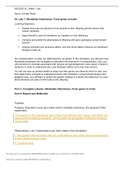
-
BIOS-256 Week 7 OL Lab 7: Mendelian Inheritance from genes to traits | GRADED A
- Exam (elaborations) • 4 pages • 2022
- Available in package deal
-
- $10.99
- + learn more
BIOS-256 Week 7 OL Lab 7: Mendelian Inheritance from genes to traits | GRADED A
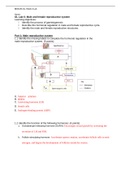
-
BIOS 256 Week 6 OL Lab 6; Male and female reproductive system
- Other • 6 pages • 2022
- Available in package deal
-
- $20.49
- + learn more
Learning objectives: • Identify the process of gametogenesis • Describe the hormonal regulation in male and female reproductivecycle. • Identify the male and female reproductivestructures. Part 1: Male reproductive system 1.1 Identify the missing labels to complete the hormonal regulation in themale reproductive system. (5points) 1.2 Identify the function of the following hormones: (4points) 1.3 Identify the parts of the human sperm. (3points) 1.4 Read the case study. Answer the ...
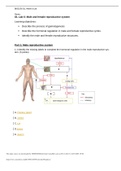
-
BIOS-256 Week 6 OL Lab 6: Male and female reproductive system | 100% GUARANTEED
- Exam (elaborations) • 9 pages • 2022
- Available in package deal
-
- $10.99
- + learn more
OL Lab 6: Male and female reproductive system Learning objectives: • Describe the process of gametogenesis • Describe the hormonal regulation in male and female reproductive cycles. • Identi fy the male and female reproductive structures. Part 1: Male reproductive system 1.1 Identify the missing labels to complete the hormonal regulation in the male reproductive sys- tem. (5 points) A. Pituitary gland B. inhibin C. LH D. testes E. Sperm 1.2 Identify the functions of each of the following h...
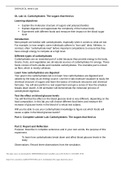
-
BIOS-256 Week 1 OL Lab 1: Carbohydrates The sugars that feed us | Already GRADED A
- Exam (elaborations) • 3 pages • 2022
- Available in package deal
-
- $10.99
- + learn more
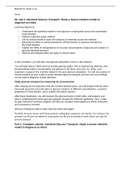
-
BIOS 256 Week 2 OL Lab 2; Intestinal Glucose Transport; Study a mouse intestine model todiagnose an infant
- Other • 3 pages • 2022
- Available in package deal
-
- $20.49
- + learn more
Learning Objectives: • Understand the epithelial model for how glucose is transported across themammalian small intestine • Perform a glucose assaymethod • Use an animal model to study the transport of materials across theintestine • Describe the effect of sodium-potassiumATPase blocker on glucose transport by the small intestine • Explain the effect of manipulations of mucosal concentrations of glucose and sodiumon glucose intestinal transport • Interpret physiological data a...
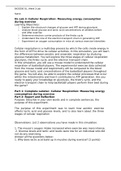
-
BIOS 256 Week 3 OL Lab 3; Cellular Respiration; Measuring energy consumption during exercise
- Other • 3 pages • 2022
- Available in package deal
-
- $20.49
- + learn more
Learning Objectives: • Explain the structural changes of glucose and ATP duringglycolysis • Analyze blood glucose and lactic acid concentrations of athletes beforeand after exercise • Determine electron carrier products of the Krebscycle • Understand the role of the electron transport chain in generatingATP • Experiment on oxygen consumption in mice at various exerciseintensities Cellular respiration is a multistep process by which the cells create energy in the form of ATP to ...
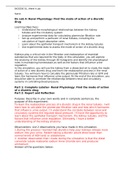
-
BIOS 256 Week 4 OL Lab 4; Renal Physiology; Find the mode of action of a diuretic drug
- Other • 3 pages • 2022
- Available in package deal
-
- $20.49
- + learn more
Learning Objectives: • Understand the morphological relationships between the kidneytubules and the circulatorysystem • Analyze experimental data for calculating glomerular filtrationrate • Set up and perform a perfusion of renal tubules, including thecalculation of liquid absorptionrates • Learn about the epithelial transport mechanism in the kidneytubules • Use experimental data to assess the mode of action of a diureticdrug Kidneys play a critical role in the filtration and ...
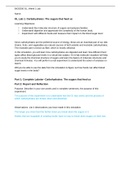
-
BIOS 256 Week 1 OL Lab 1; Carbohydrates The sugars that feed us
- Other • 3 pages • 2022
- Available in package deal
-
- $20.49
- + learn more
OL Lab 1: Carbohydrates: The sugars that feed us Learning Objectives: • Understand the molecular structure of sugars andpolysaccharides • Understand digestion and appreciate the complexity of the humanbody • Experiment with different foods and measure their impact on the blood sugarlevel Since carbohydrates are the preferred source of energy, these are an essential part of our diet. Grains, fruits, and vegetables are natural sources of both soluble and insoluble carbohydrates. The...
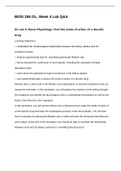
-
BIOS 256 OL, Week 4 Lab Q&A
- Exam (elaborations) • 5 pages • 2022
-
- $7.99
- + learn more
BIOS 256 OL, Week 4 Lab Q&A OL Lab 4: Renal Physiology: Find the mode of action of a diuretic drug Learning Objectives: • Understand the morphological relationships between the kidney tubules and the circulatory system • Analyze experimental data for calculating glomerular filtration rate • Set up and perform a perfusion of renal tubules, including the calculation of liquid absorption rates • Learn about the epithelial transport mechanism in the kidney tubules • Use experime...
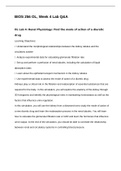
-
BIOS 256 OL, Week 4 Lab Q&A
- Exam (elaborations) • 5 pages • 2022
-
- $7.99
- + learn more
BIOS 256 OL, Week 4 Lab Q&A OL Lab 4: Renal Physiology: Find the mode of action of a diuretic drug Learning Objectives: • Understand the morphological relationships between the kidney tubules and the circulatory system • Analyze experimental data for calculating glomerular filtration rate • Set up and perform a perfusion of renal tubules, including the calculation of liquid absorption rates • Learn about the epithelial transport mechanism in the kidney tubules • Use experime...

How did he do that? By selling his study resources on Stuvia. Try it yourself! Discover all about earning on Stuvia


